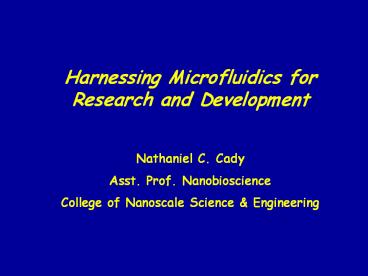Harnessing Microfluidics for Research and Development PowerPoint PPT Presentation
1 / 35
Title: Harnessing Microfluidics for Research and Development
1
Harnessing Microfluidics for Research and
Development Nathaniel C. Cady Asst. Prof.
Nanobioscience College of Nanoscale Science
Engineering
2
- Outline
- Fluid dynamics (for non-majors)
- Building microfluidic devices
- Examples of research devices
3
Turbulent Flow
4
Laminar Flow
5
Flow regime is predictable!
Reynolds Number
Re (density) x (velocity) x (diameter)
(viscosity) If Re 3000 or higher
turbulent flow If 2000-3000 transitional
flow If less than 2000 laminar flow 2300
transition point
Microfluidic devices capitalize on small channel
sizes to control flow regime
6
- Advantages of Microfluidic Devices
- Well-controlled fluid dynamics
- Diffusion-limited mixing
- Controllable fluid interactions
- Small fluid volume
- Less sample and reagent needed
- More samples per unit area (multiplexing)
- Microfluidics Lab-on-a-chip
7
Device Fabrication
8
- Fabrication of Microfluidic Devices
- Fabrication schemes range from simple to highly
complex - Primarily rely on micro / nanofabrication
techniques - Lithography (photo-, electron beam, imprint)
- Etching or molding of 3-D channels
- Capping or enclosure of channels
9
Photolithography
Transfer Pattern
Develop Resist
Etch substrate
Remove Resist
10
Making a Microfluidic Device
Direct
Indirect
11
Fabrication is relatively easy
12
Practical Applications Diagnostics
13
Microchip-based DNA Biosensor
35mm
20 mm
Integrated DNA Purification Real-Time PCR
14
DNA-based Diagnostics
EtOH (wash buffer)
GuSCN (lysis buffer)
dH2O (elution buffer)
15
Micropillars for DNA Purification
10 microns
16
Integrated Control System
17
Detection Results
Cady et. al. (2005) Sensors Actuators B.
107(1) 332-341 Cady et. al. (2003) Biosensors
Bioelectronics. 19 59-66
18
Practical Applications Micro Printing
Patterning
19
Biomolecular Printing
30 microns
20
Probing Neural Networks
Signaling ?
SiO2
Gold
Glass
With Dr. Bill Shain Dr. Matt Hynd Wadsworth
Center, NYS Dept. of Health
21
Biomolecular Printing
Insert movie
22
Printed Guidance for Neural Networks
- Microelectrode arrays (MEAs) coated with
PEG-based hydrogel - NeN used to pattern hydrogel with FITC-labeled
bioactive peptides - Successful printing of both spots and lines
200um
Microelectrode Array (MEA)
Hydrogel-coated MEA patterned with the laminin
peptide, biotin-IKVAV. The laminin peptide
biotin-IKVAV was printed onto using the automated
NanoEnabler bioprinter. Printed peptide was
arranged in a pattern consisting of orthogonal 2
mm-wide lines connecting 10 mm diameter node.
Courtesy of Matthew Hynd, PhD NYS DOH
23
Neural Networks
- Printed MEAs seeded with primary hippocampal
neurons - Cells proliferated on the arrays and formed
neural network on MEAs - Results were comparable to studies using
microcontact printing methods
(Hynd, et. al., J. Neuroscience Methods, 2006)
200um
Patterned neuronal network at 2 weeks in vitro.
Primary hippocampal neurons were plated onto
patterned arrays at a density of 400 cells/mm2.
Scanning electron microscope image of patterned
neural network.
Courtesy of Matthew Hynd, PhD NYS DOH
24
Cellular Printing
Slow, difficult
High acceleration / thermal exposure
potentially damaging to cells
25
Direct Cell Printing
- Polymeric Surface Patterning Tool
- Developed at CNSE, UAlbany (Cady Lab)
- Designed to enable live cell printing directly
onto solid surfaces - Larger channels and cantilever allow for whole
cells to be printed
Fluid Reservoir
Channel
Printing Tip
BioForce Silicon-based SPT
Polymeric SPT
26
Bacterial Cell Printing
E. coli pET28A-GFP on polystyrene
20 µm
20 µm
20 µm
27
Mammalian Cell Printing
Mouse MTLn3-GFP (diluted) printed on polystyrene
50 µm
28
Practical Applications Cell Dynamics
29
Biomimetic Device for Tumor Cell Dissemination
Studies
Weir Structures (Constrictions)
Collection Area
O2 Input
Output
Tumor Cell Input
1000µm
Cell
Weir Structures (Constrictions)
30
Flow Cell Design
Device Filled with Dye
500µm
Fluid Flow Direction
31
Fluid Dynamic Modeling
Fluid velocity vectors
Units (cm/sec)
500µm
32
Device Testing
HEp3 Cells (Human Epidermal Carcinoma 3)
Fluid Flow
Cells were smaller than anticipated needed
different weir spacing!
100um
33
Rapid Prototyping of New Device
Fluid Flow
100um
34
Summary
- Microfluidic devices reduce sample volume and
offer unique fluid dynamic environments - Novel fluid dynamics can affect reaction rates,
diffusion, biological processes - Practical applications (like patterning) can be
accomplised using microfluidics - Novel fluid environments can be used for
biomimetic studies
35
Acknowledgements
University at Albany Mt. Sinai Dr. Robert
Geer Dr. Julio Aguirre-Ghiso Dr. Magnus
Bergkvist Dr. Alain Kaloyeros Research
Support UAlbany Startup Funds UAlbany FRAP AB
Awards BioForce Instruments CNSE / CAS
Challenge Grant

